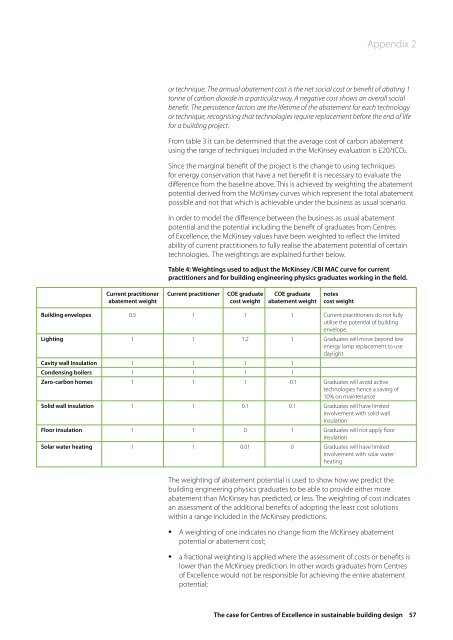The case for Centres of Excellence in sustainable building design
The case for Centres of Excellence in sustainable building design
The case for Centres of Excellence in sustainable building design
You also want an ePaper? Increase the reach of your titles
YUMPU automatically turns print PDFs into web optimized ePapers that Google loves.
Appendix 2<br />
or technique. <strong>The</strong> annual abatement cost is the net social cost or benefit <strong>of</strong> abat<strong>in</strong>g 1<br />
tonne <strong>of</strong> carbon dioxide <strong>in</strong> a particular way. A negative cost shows an overall social<br />
benefit. <strong>The</strong> persistence factors are the lifetime <strong>of</strong> the abatement <strong>for</strong> each technology<br />
or technique, recognis<strong>in</strong>g that technologies require replacement be<strong>for</strong>e the end <strong>of</strong> life<br />
<strong>for</strong> a build<strong>in</strong>g project.<br />
From table 3 it can be determ<strong>in</strong>ed that the average cost <strong>of</strong> carbon abatement<br />
us<strong>in</strong>g the range <strong>of</strong> techniques <strong>in</strong>cluded <strong>in</strong> the McK<strong>in</strong>sey evaluation is £20/tCO2.<br />
S<strong>in</strong>ce the marg<strong>in</strong>al benefit <strong>of</strong> the project is the change to us<strong>in</strong>g techniques<br />
<strong>for</strong> energy conservation that have a net benefit it is necessary to evaluate the<br />
difference from the basel<strong>in</strong>e above. This is achieved by weight<strong>in</strong>g the abatement<br />
potential derived from the McK<strong>in</strong>sey curves which represent the total abatement<br />
possible and not that which is achievable under the bus<strong>in</strong>ess as usual scenario.<br />
In order to model the difference between the bus<strong>in</strong>ess as usual abatement<br />
potential and the potential <strong>in</strong>clud<strong>in</strong>g the benefit <strong>of</strong> graduates from <strong>Centres</strong><br />
<strong>of</strong> <strong>Excellence</strong>, the McK<strong>in</strong>sey values have been weighted to reflect the limited<br />
ability <strong>of</strong> current practitioners to fully realise the abatement potential <strong>of</strong> certa<strong>in</strong><br />
technologies. <strong>The</strong> weight<strong>in</strong>gs are expla<strong>in</strong>ed further below.<br />
Table 4: Weight<strong>in</strong>gs used to adjust the McK<strong>in</strong>sey /CBI MAC curve <strong>for</strong> current<br />
practitioners and <strong>for</strong> build<strong>in</strong>g eng<strong>in</strong>eer<strong>in</strong>g physics graduates work<strong>in</strong>g <strong>in</strong> the field.<br />
Current practitioner Current practitioner COE graduate COE graduate notes<br />
abatement weight cost weight abatement weight cost weight<br />
Build<strong>in</strong>g envelopes 0.5 1 1 1 Current practitioners do not fully<br />
utilise the potential <strong>of</strong> build<strong>in</strong>g<br />
envelope.<br />
Light<strong>in</strong>g 1 1 1.2 1 Graduates will move beyond low<br />
energy lamp replacement to use<br />
daylight<br />
Cavity wall Insulation 1 1 1 1<br />
Condens<strong>in</strong>g boilers 1 1 1 1<br />
Zero-carbon homes 1 1 1 -0.1 Graduates will avoid active<br />
technologies hence a sav<strong>in</strong>g <strong>of</strong><br />
10% on ma<strong>in</strong>tenance<br />
Solid wall <strong>in</strong>sulation 1 1 0.1 0.1 Graduates will have limited<br />
<strong>in</strong>volvement with solid wall<br />
<strong>in</strong>sulation<br />
Floor <strong>in</strong>sulation 1 1 0 1 Graduates will not apply floor<br />
<strong>in</strong>sulation<br />
Solar water heat<strong>in</strong>g 1 1 0.01 0 Graduates will have limited<br />
<strong>in</strong>volvement with solar water<br />
heat<strong>in</strong>g<br />
<strong>The</strong> weight<strong>in</strong>g <strong>of</strong> abatement potential is used to show how we predict the<br />
build<strong>in</strong>g eng<strong>in</strong>eer<strong>in</strong>g physics graduates to be able to provide either more<br />
abatement than McK<strong>in</strong>sey has predicted, or less. <strong>The</strong> weight<strong>in</strong>g <strong>of</strong> cost <strong>in</strong>dicates<br />
an assessment <strong>of</strong> the additional benefits <strong>of</strong> adopt<strong>in</strong>g the least cost solutions<br />
with<strong>in</strong> a range <strong>in</strong>cluded <strong>in</strong> the McK<strong>in</strong>sey predictions.<br />
• A weight<strong>in</strong>g <strong>of</strong> one <strong>in</strong>dicates no change from the McK<strong>in</strong>sey abatement<br />
potential or abatement cost;<br />
• a fractional weight<strong>in</strong>g is applied where the assessment <strong>of</strong> costs or benefits is<br />
lower than the McK<strong>in</strong>sey prediction. In other words graduates from <strong>Centres</strong><br />
<strong>of</strong> <strong>Excellence</strong> would not be responsible <strong>for</strong> achiev<strong>in</strong>g the entire abatement<br />
potential;<br />
<strong>The</strong> <strong>case</strong> <strong>for</strong> <strong>Centres</strong> <strong>of</strong> <strong>Excellence</strong> <strong>in</strong> susta<strong>in</strong>able build<strong>in</strong>g <strong>design</strong> 57

















